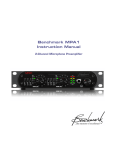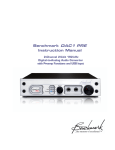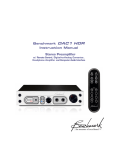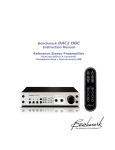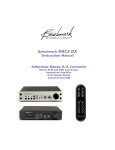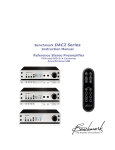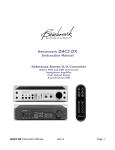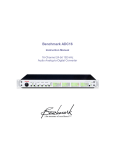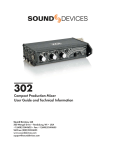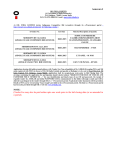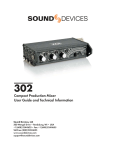Download Benchmark MPA1 Instruction manual
Transcript
Benchmark PRE420 Instruction Manual 4-Channel Microphone Preamplifier/Mixer Safety Information Voltage Selection CAUTION: THE FUSE DRAWER INCLUDES A VOLTAGE SELECTION SWITCH WITH TWO SETTINGS: “110” AND “220”. CHECK TO SEE THAT IT IS PROPERLY CONFIGURED FOR YOUR LOCATION BEFORE CONNECTING AC POWER. Incorrect configuration may blow fuses or cause erratic operation. Repairs CAUTION: DO NOT SERVICE OR REPAIR THIS PRODUCT UNLESS PROPERLY QUALIFIED. ONLY A QUALIFIED TECHNICIAN SHOULD PERFORM REPAIRS. Fuses CAUTION: FOR CONTINUED FIRE HAZARD PROTECTION ALWAYS REPLACE THE FUSES WITH THE CORRECT SIZE AND TYPE (0.5A 250 V SLO-BLO® 5 X 20 MM – LITTELFUSE® HXP218.500 OR EQUIVALENT). Modifications CAUTION: DO NOT SUBSTITUTE PARTS OR MAKE ANY MODIFICATIONS WITHOUT THE WRITTEN APPROVAL OF BENCHMARK MEDIA SYSTEMS, INC. MODIFICATION MAY CREATE SAFETY HAZARDS AND VOID THE WARRANTY. NOTICE: CHANGES OR MODIFICATIONS NOT EXPRESSLY APPROVED BY BENCHMARK MEDIA SYSTEMS COULD VOID THE USER'S AUTHORITY TO OPERATE THE EQUIPMENT UNDER FCC REGULATIONS. Contents Safety Information 2 Voltage Selection Repairs Fuses Modifications 2 2 2 2 Contents 3 Overview 4 Features 6 Connections 7 Microphone Inputs (1-4) Balanced Outputs – Overview Driving Unbalanced Loads Output Signal Levels Direct Outputs (1-4) Control Room Outputs (L&R) Main Outputs (L&R) AC Power Entry Connector Fuse Holder Preamp Section Preamp Overview Input Topology Microphone Gain Controls Blocking RF, EMI, and Noise Phantom Power Switches Input Protection MirrorPan™ Pan Controls 20 dB Pads Terminating Unused Inputs 40 Hz High-Pass Filters LED Meters – Direct Outputs Solo Bus 7 7 8 8 8 8 8 8 8 9 9 9 9 9 9 9 11 11 11 11 11 12 Solo Switches Stereo/Mono Solo Switch 12 12 Control Room Outputs 13 Control Room Mute Switch Driving Unbalanced Loads Monitor Fader 13 13 13 HPA2™ Headphone Output 14 “0-Ohm” Output Impedance Headphone Performance 14 14 Mix Outputs Driving Unbalanced Loads Main Fader LED Meters – Mix Outputs Rack Mounting Mounting Near Other Equipment Performance Graphs Frequency Response High-Pass Filter - Frequency Response Inter-Channel Phase Response THD+N vs. Frequency Wideband THD+N vs. Frequency Equivalent Input Noise vs. Gain Noise Spectrum THD Spectrum at 1 KHz THD Spectrum at 10 KHz Specifications Microphone Preamps Direct Outputs Control Room and Main Outputs MirrorPan™ Constant-Power Pan Circuit HPA2™ Headphone Amplifier LED Status Indicators and Meters AC Power Requirements Dimensions Weight Regulatory Compliance FCC Notice RoHS Compliant Information CE Certificate of Conformity Warranty Information Benchmark Extended Warranty Calibration Required Equipment +48V Adjustment Microphone Gain and Metering Monitor Gain Balance Microphone Pan Balance Main Gain Balance Peak LED Adjust – Main Outputs 15 15 15 15 16 16 17 17 18 19 20 21 22 23 24 25 26 26 27 27 28 28 29 29 30 30 31 31 31 32 33 34 35 35 35 35 35 35 36 36 Overview The PRE420 is a 4-channel microphone preamplifier/mixer and is designed to achieve the highest performance available in a microphone preamplifier. The PRE420 is designed for maximum transparency, wide bandwidth, low-noise, low-distortion, and superior RF immunity. It is well suited for the most demanding applications in studios and live venues. The PRE420 is the next evolution of Benchmark’s legendary MPS-420 microphone preamplifier. We have improved the performance while adding meters, a mix bus, a solo bus, and an internal power supply. The added features do not compromise the performance of the classic Benchmark design. In all respects, the PRE420 meets or exceeds the performance of the MPS series preamps. The PRE420 features an astonishingly lownoise stereo mix bus driven by Benchmark's proprietary MirrorPan™ circuitry to achieve precise, distortion-free, constant-power panning. The mix bus allows pristine directto-stereo recording from up to 4 microphones. The balanced stereo outputs are equipped with meters and a master level control. A solo bus allows monitoring of individual microphones as well as any stereo or mono mix of microphones. The solo bus is routed to the balanced control room outputs and to the headphone amplifier. The control room outputs have a switch that enables mute on headphone insertion. The PRE420 includes the HPA2™ Benchmark's signature high-current, 0-Ohm PRE420 Instruction Manual – rev. E headphone amplifier. The HPA2™ is capable of delivering the full performance of the PRE420 into the difficult loading presented by many headphones. Each of the PRE420's four microphone inputs includes switches for +48V Phantom power, a 20dB pad, and a 40Hz high-pass filter. The PRE420 achieves outstanding performance over a wide range of input levels. Gain is controlled by matched 41-detent pots and is adjustable over a range of 22dB to 60dB (without pad), or 2dB to 40dB (with pad enabled). The mix bus can provide an additional gain of up to 6 dB. The PRE420 has four direct outputs, two control room outputs, and two stereo outputs. All outputs feature low-distortion, highcurrent drivers that easily handle long cables and other less-than-ideal loads. A rugged 1 RU enclosure includes an internal power supply that supports all international voltages and has generous margins for overvoltage and under-voltage conditions. It features a core-banded toroidal transformer in a shielded enclosure. The entire signal path of the PRE420 has a generously wide bandwidth: 500 kHz. This creates a significant demand for exceptional RF filtering and shielding – a demand Benchmark fulfills. All signal paths in the PRE420 are aggressively protected from RF and magnetic interference. For example, a special construction technique is employed with the multi-layer printed circuit board to create a 3Page 4 dimensional shield surrounding the microphone-level signal traces to block RF interference. Also, the microphone-level traces are arranged in a star-quad layout to prevent magnetic interference. Benchmark's innovative shielding and filtering techniques have given Benchmark microphone-preamps a proven track record for exceptional performance in difficult, RF-intensive locations. This RF-immunity is coupled with ultra-low distortion performance at high-frequencies, beyond that of most mic-preamps, giving your audio remarkable realism. With an amazingly low THD+N of 0.00024% (see specs), we encourage you to compare the PRE420's performance specifications and sonic performance with any other micpreamp. Microphone pre-amplifier circuits usually suffer from non-linear performance at ultrasonic frequencies. This non-linearity causes inter-modulation distortion (IMD) components that fold down to audible frequencies. Unlike harmonic distortion (THD), IMD produces distortion tones that are very un-natural and non-musical. IMD also masks and alters the subtle details of delicate high-frequency transients such as those produced by bells. Benchmark MPS series preamps have always had outstanding high-frequency performance as well as freedom from IMD. The PRE420 takes the Benchmark design one step further, and achieves the lowest IMD that we have ever measured in a microphone preamplifier. We believe that you will enjoy the sonic performance and features of the PRE420. PRE420 Instruction Manual – rev. E Page 5 Features • • • • • • • • • • • • • • • • • • • • • • • • • • • • • • • • Four Transformerless Microphone Inputs Four Balanced Direct Outputs (XLR) Balanced Left and Right Main Outputs (XLR) Balanced Left and Right Control Room Outputs (XLR) HPA2™ “0-Ohm” 1/4” TRS Headphone Output Precision-Matched Monolithic Low-Noise Transistor Quads on Each Microphone Input High-Current High-Speed Low-Capacitance Phantom Protection Circuits Fully Protected Against Phantom Hot-Plug and Cable-Shorting Scenarios Balanced Transformerless Inputs and Outputs +48v Phantom Power Switch on Every Microphone Input 40 Hz High-Pass Filter Switch on Every Microphone Input (12 dB/octave) 20 dB Pad Switch on Every Microphone Input Matched 41-Detent First-Stage Gain Controls on Every Microphone Input 60 dB Maximum First-Stage Gain, Adjustable to 70 dB 22 to 60 dB Gain (pad off), 2 to 40 dB (pad on) +27 dBu Maximum Input Level (with pad), +7 dBu (without pad) +29.5 dBu Maximum Output Level on all Balanced Outputs + 23.5 dBu Maximum Headphone Output Level MirrorPan™ Low-Distortion Constant-Power Pan Controls (1 per input channel) Solo Switches (1 per input channel) Mono/Stereo Solo Switch for Flexible Monitoring 41-Detent Control Room/Headphone Level Control 41-Detent Main Output Level Control Control Room “Mute on Headphone Insertion” Mode Switch (rear panel) Intensity Modulated Signal Presence LEDs (Green - 4 on direct outputs plus 2 on main outputs) +24 dBu Warning LED (Red – 4 on direct outputs plus 2 on main outputs) Solo Warning LED (Yellow) +48V Phantom Warning Indicators (Yellow - 1 per input channel) Power LED (Blue) Ultra-Quiet Linear Power Supply with Rear-Panel Input Voltage Selector Complies with FCC and CE Regulations RoHS Compliant PRE420 Instruction Manual – rev. E Page 6 Connections Microphone Inputs (1-4) The balanced transformerless microphone inputs use locking Neutrik™ gold-pin female XLR jacks with both pin 1 (Ground) and the XLR shell directly bonded to the chassis. This direct bonding is important for maximum RF shielding and for immunity to hum due to shield currents. • • • • XLR pin 2 = + Audio In XLR pin 3 = - Audio In XLR pin 1 = Cable Shield – bonded to chassis XLR shell – bonded to chassis The microphone inputs have a wide operating range. With the pad enabled, maximum input level is +28 dBu. With the pad off, maximum input level is +8 dBu. All inputs are equipped with +48V phantom power, and each input has its own phantom power switch. Under certain circumstances, phantom power can cause large voltage transients. The PRE420 is equipped with high-current input protection circuits that protect the sensitive low-noise input transistors from the worst-case phantominduced transients. Large transients are produced when a microphone is connected or disconnected while phantom power is on. The worst possible transients occur when a microphone cable has an intermittent short to ground from either pin 2 or pin 3. The PRE420 is very well protected against both of the above. For the protection of your microphones (and your ears), we strongly recommend shutting off phantom power several seconds before connecting or disconnecting a microphone. PRE420 Instruction Manual – rev. E The first generation of PRE420’s (with fivedigit serial numbers) featured a commonmode choke for RF immunity. These choke filters were designed for balanced microphone or balanced line-level inputs. When using the PRE420 with unbalanced sources, the user should insert the internal jumpers that bypass the choke (J5-J12). The frequency response of the PRE420’s is 500 kHz, but the choke will limit the frequency response of an unbalanced input to 26 kHz if the choke is not bypassed. This difference is because of the nature of common-mode chokes. RF interference signals tend to be common-mode signals, and the choke filter has excellent common-mode rejection at ultrasonic and RF frequencies. The common-mode rejection of the choke filter is 60 dB at 1 MHz. The second generation (with eight- or ninedigit serial numbers) features a new RF and EMI filtering mechanism (the same used in the Benchmark MPA1 microphone preamplifier). The RF performance of the second generation is nearly identical to the first generation PRE420, with the added advantage that the new design is compatible with unbalanced sources without the need to use jumpers. The newer design works equally with balanced and unbalanced sources. It features star-quad signal distribution between the microphone input jacks and the preamplifier circuit. This starquad signal path is immune to magnetic interference that may be caused by adjacent equipment in a tightly packed rack. Balanced Outputs ---- Overview The PRE420 has 8 balanced outputs including four direct outputs, two control room outputs, and two main outputs. All outputs use goldPage 7 pin Neutrik™ male XLR connectors with direct chassis bonding of both pin 1 and the connector shell. This direct bonding is important for maximum RF shielding and for immunity to hum due to shield currents. All outputs are transformerless and have an impedance of 60 Ohms balanced or 30 Ohms unbalanced. All outputs are equipped with high-performance drivers that can drive high signal levels into load impedances as low as 300 Ohms without an increase in distortion. These outputs are well suited for driving long lines. • • • • XLR pin 2 = + Audio Out XLR pin 3 = - Audio Out XLR pin 1 = Cable Shield – bonded to chassis XLR shell – bonded to chassis Driving Unbalanced Loads Special cables are required for driving unbalanced loads: • • • Connect XLR pin 2 to audio in Connect XLR pin 1 to shield Make no connection to XLR pin 3 – this pin must be left floating when driving unbalanced loads Output Signal Levels The maximum output level on all balanced outputs is 29.5 dBu. The four direct outputs and the two main outputs are equipped with two-segment LED meters. The green LED shows signal presence with varying intensity based on signal level over a range of -8 dBu to +24 dBu. The green LED reaches half brightness at an output level of about +4 dBu, and is near full brightness at +24 dBu. The red LED is factory preset to illuminate at an output level of precisely +24 dBu, but may be adjusted to other levels between 20 dBu and 29 dBu. The red LED is driven by a peak detection and stretching circuit so that very short transients can be observed. The red LED is a warning indicator; it is not a clip indicator. PRE420 Instruction Manual – rev. E Direct Outputs (1-4) Each microphone preamp has its own direct output. Each output has a dual-segment LED meter. Control Room Outputs (L&R) The solo bus is routed post-fader to the Control Room Outputs. A rear-panel switch allows these outputs to mute upon headphone insertion if desired. Main Outputs (L&R) The mix bus is routed post fader to the main outputs. Both outputs have a dual-segment LED meter. AC Power Entry Connector The AC power input uses a standard IEC type connector and includes a power switch. Factory-configured 110V units ship with a power cord. 220V units ship without a power cord, as they are location-specific and may be purchased from a local source. Fuse Holder The fuse holder is built into a drawer next to the IEC power connector. The drawer requires two 5 x 20 mm 250 V Slo-Blo® Type fuses. The drawer includes a voltage selection switch with two settings: “110” and “220”. Both settings use a 0.5 Amp fuse. The AC input has a very wide input voltage range and can operate over a frequency range of 50 to 60 Hz. At the “110” setting, the PRE420 will operate normally over a range of 105 to 140 VAC. At the “220” setting, the PRE420 will operate normally over a range of 200 to 285 VAC. CAUTION: FOR CONTINUED FIRE HAZARD PROTECTION ALWAYS REPLACE THE FUSES WITH THE CORRECT SIZE AND TYPE (0.5A 250 V SLO-BLO® 5 X 20 MM – LITTELFUSE® HXP218.500 OR EQUIVALENT). Page 8 Preamp Section Blocking RF, EMI, and Noise The entire signal path of the PRE420 has a generously wide bandwidth: 500 kHz. This creates a significant demand for exceptional RF filtering and shielding – a demand Benchmark fulfills. Preamp Overview Each preamp channel includes switches for phantom power, a 20 dB pad, and a 40 Hz high-pass filter. Each channel also has a center-detent MirrorPan™ control, a 41detent gain control, a Phantom warning LED, and a 2-segment output level meter. Inputs are fully protected against overloads and phantom power transients. Input Topology The first gain stage on each microphone input is built around precision-matched monolithic low-noise transistor quads. Bandwidth is 500 kHz, IMD and THD are virtually non-existent. The PRE420 is designed to achieve faithful and transparent microphone amplification. Microphone Gain Controls These controls are a 41-detent pots that accurately set the first-stage gain of each preamplifier. These controls are calibrated for precise minimum and maximum gain. This calibration provides accurate channel-tochannel matching, and allows precise control of stereo microphone pairs. Maximum gain is calibrated for exactly 60 dB, but may be adjusted to any value between 50 and 70 dB using the calibration procedure in this manual. Minimum gain is 22 dB without the pad, and 2 dB with the pad enabled. TIP: ENGAGE THE PAD ON ANY UNUSED INPUT AND TURN THE MICROPHONE GAIN CONTROL TO MINIMUM TO REDUCE NOISE AT THE MIXER OUTPUTS. PRE420 Instruction Manual – rev. E All signal paths in the PRE420 are aggressively protected from RF and EMI (electro-magnetic interference). For example, the multi-layer printed circuit board uses a special construction technique that creates a 3-dimensional shield surrounding each miclevel signal-trace to block RF interference. Star-quad trace layouts prevent magnetic interference. Benchmark's innovative shielding and filtering techniques have given Benchmark mic-preamps a proven track record for exceptional performance even in the most difficult environments. Common mode signals in the audio band are removed with a precisely trimmed differential amplifier. The PRE420 even includes a subsonic common-mode trim adjustment on each microphone input that eliminates sensitivity to +48V ripple caused by power supply noise and/or the loading of microphone electronics. Phantom Power Switches • • In = Phantom On Out = Phantom Off Each channel has a +48V warning LED that will illuminate when +48V is present on the microphone inputs. CAUTION: ALWAYS TURN OFF PHANTOM POWER AND WAIT FOR THE +48V LED TO GO OUT BEFORE CONNECTING OR DISCONNECTING MICROPHONES. Input Protection Under certain circumstances, phantom power can cause large voltage transients. The PRE420 is equipped with high-speed highPage 9 current low-capacitance input protection circuits that protect the sensitive low-noise input transistors from the worst-case phantom-induced transients. Large transients are produced when a microphone is connected or disconnected while phantom power is on. The worst possible transients occur when a microphone cable has an intermittent short to ground from either pin 2 or pin 3. The PRE420 is very well protected against both of the above. For the protection of your microphones (and your ears), we strongly recommend shutting off phantom power several seconds before connecting or disconnecting a microphone. PRE420 Instruction Manual – rev. E Page 10 MirrorPan™ Pan Controls The PRE420 incorporates Benchmark’s new MirrorPan™ constant-power pan control. The advantages of MirrorPan™ include: • • • • • Accurate 3-dB constant-power pan law Accurate balance at center detent Excellent channel separation when fully panned Ultra-low distortion Ultra-low noise Benchmark’s MirrorPan circuit eliminates the distortion and pan-law errors caused by panpot wiper current. The center detent is precisely calibrated for an accurate center pan, and channel separation is excellent when fully panned. 20 dB Pads • • In = Pad Enabled Out = Pad Off The 20 dB Pad allows the connection of line level signals as high as 27 dBu. Without the pad, the maximum input level is 7 dBu. The input impedance of the PRE420 is 1.37k Ohms with the pad enabled and 8.13k Ohms when the pad is off. The pad is constructed from two 750 Ohm series resistors plus one 150 Ohm shunt resistor. Terminating Unused Inputs The pad should be used to apply a 150 Ohm termination to an unused microphone input. Microphone preamplifiers will amplify the Johnson noise from the source resistance connected to the input. Most microphones have a source resistance of about 150 Ohms. But, an un-terminated preamplifier sees only its own input impedance. The input impedance of the PRE420 is 8.13k Ohms. The Johnson noise of a 150-Ohm resistor is -130.8 dBu while the Johnson noise from an 8.13k-Ohm resistor is -113.5 dBu. An unterminated microphone input will be about 17 dB noisier than an input that is properly terminated. PRE420 Instruction Manual – rev. E The 20dB pad applies a 150-Ohm resistor across the inputs of the preamplifier. Engaging the pad on an unused input terminates the preamplifier with approximately the same resistance as a typical microphone, and drops the EIN of the preamplifier to its specified value. If a microphone is not connected, engage the pad to terminate the input. TIP: ENGAGE THE PAD ON ANY UNUSED INPUT AND TURN THE MICROPHONE GAIN CONTROL TO MINIMUM TO REDUCE NOISE AT THE MIXER OUTPUTS. 40 Hz High-Pass Filters • • In = Filter Enabled Out = Filter Off The 40 Hz high-pass filter is a second-order filter with a slope of 12 dB per octave. This filter is intended to remove unwanted subsonic noise and rumble caused by sources such as HVAC, air currents, and vibration. LED Meters ---- Direct Outputs Each preamp channel has a direct output. Each direct output is equipped with a twosegment LED meter. The green LED shows signal presence. The intensity of the green LED varies with signal level over a range of -8 dBu to +24 dBu. The green LED reaches half brightness at an output level of about +4 dBu, and is near full brightness at +24 dBu. The red LED is factory preset to illuminate at an output level of precisely +24 dBu, but may be adjusted to other levels between 20 dBu and 29 dBu. The red LED is driven by a peak detection and stretching circuit so that very short transients can be observed. The red LED is a warning indicator not a clip indicator. The direct outputs have 5.5 dB of remaining headroom when the red LED is just illuminated. The mix amps have a minimum of 2 dB of headroom when all channels are just illuminating the red LEDs. Page 11 Stereo/Mono Solo Switch Microphones may be monitored before the pan control (mono) or after the pan control (stereo). Press the “Mono/Stereo” switch for stereo solo. Stereo monitoring can be used to check the pan position of a single microphone or any combination of microphones. Solo Bus The PRE420 has a flexible solo bus that allows: • • • • Mono monitoring of any mix of microphones Stereo (post pan) monitoring of any combination of microphones Stereo monitoring of the main mix bus Mono monitoring of the main mix bus The output of the solo bus is directed to the “monitor” fader and then to the headphone and “control room” outputs. If none of the 4 microphone solo buttons are pressed, the main stereo mix is directed to the solo bus. NOTE: The “Mono/Stereo” switch is only functional when one or more microphone solo buttons are pressed. This makes it easy to toggle between the main stereo mix and a mono solo of a single microphone. TIP: TO CHECK A MIX FOR MONOCOMPATIBILITY, PRESS ALL 4 MICROPHONE SOLO BUTTONS. THEN, USE THE “MONO/STEREO” BUTTON TO TOGGLE BETWEEN THE MONO MIX AND THE MAIN STEREO MIX. Solo Switches The solo bus has one solo button for each of the 4 channels. These can be pressed in any combination to create a mix of microphones. If any microphone solo button is pressed, the “Solo” indicator will illuminate. PRE420 Instruction Manual – rev. E Page 12 Control Room Monitor Fader Outputs The output of the solo bus is directed to the “monitor” fader and then to the headphone and “control room” outputs. Maximum output level is 29.5 dBu. All drivers are high-current low-distortion amplifiers. These are capable of driving loads as low as 300 Ohms without an increase in distortion. The “monitor” fader is located to the right of the solo buttons. It controls the output level of the headphone jack and the balanced control room outputs. This stereo fader has factory-adjusted balance trim circuitry to provide accurate L/R balance. Control Room Mute Switch TIP: THE “CONTROL ROOM” OUTPUTS CAN BE SET TO AUTOMATICALLY MUTE WHENEVER A HEADPHONE IS INSERTED. PRESS THE REAR-PANEL BUTTON TO ENABLE THE AUTO-MUTE FUNCTION. Driving Unbalanced Loads CAUTION: ALWAYS LEAVE XLR PIN 3 FLOATING WHEN DRIVING UNBALANCED LOADS. XLR to RCA Wiring: 1. Connect XLR pin 2 (+) to RCA center pin. 2. Connect XLR pin 1 (GND) to RCA shield. 3. Make no connection to XLR pin 3 (-). XLR to ¼” TS Wiring: 1. Connect XLR pin 2 (+) to Tip. 2. Connect XLR pin 1 (GND) to Sleeve. 3. Make no connection to XLR pin 3 (-). PRE420 Instruction Manual – rev. E Page 13 HPA2™ Headphone Output The output of the solo bus is directed to the “monitor” fader and then to the headphone and “control room” outputs. The headphone output is driven by Benchmark’s signature HPA2™ headphone amplifier. This high-current, high-output amplifier has an output impedance of 0Ohms. It is designed to drive loads as low as 30-Ohms without any increase in distortion. It also has sufficient amplitude to drive lowsensitivity 600-Ohm headphones. impedance decreases. This distortion can be eliminated with a properly designed 0-Ohm headphone amplifier. The performance of the HPA2™ does not change when headphones are driven. THD+N measurements for no-load, 30-Ohm resistive load, and 30-Ohm headphone load, and 600Ohm headphone load are virtually identical. The HPA2™ will substantially improve the sound of 30 and 60-Ohm headphones. It will make very noticeable improvements with 600-Ohm headphones. The HPA2™ includes current-limiting circuits that fully protect against damage from short circuits. This is important because the right channel of a headphone amplifier will experience a short whenever a mono phone plug is inserted into the stereo headphone jack. Shorts may also occur when a plug is partially inserted. ‘‘0-Ohm’’ Output Impedance Most headphone amplifiers use series resistors to maintain stability and protect against short-circuit conditions. These resistors are usually at least 30-Ohms, and have a negative impact on performance. A headphone amplifier with series resistors may measure very well when driving resistive loads. However, the same amplifier will measure very poorly when driving a headphone load. Unfortunately most manufacturers do not specify headphone amplifier performance with anything other than ideal resistive loads. Our measurements show that headphones do not behave like resistive loads. Headphone Performance In our tests we have measured substantial distortion across resistors that are wired in series with headphones. We conducted measurements with a variety of headphones. In general, distortion increases as headphone PRE420 Instruction Manual – rev. E Page 14 Mix Outputs Main Fader The output of the mix bus is directed to the “Main” fader and then to the “Main” outputs. The “main” fader is located at the far right of the front panel. This stereo fader has factory adjusted balance trim circuitry to provide accurate L/R balance. Maximum output level is 29.5 dBu. All drivers are high-current low-distortion amplifiers. These are capable of driving loads as low as 300 Ohms without an increase in distortion. LED Meters ---- Mix Outputs TIP: ENGAGE THE PAD ON ANY UNUSED INPUT AND TURN THE MICROPHONE GAIN CONTROL TO MINIMUM TO REDUCE NOISE AT THE MIXER OUTPUTS. Driving Unbalanced Loads CAUTION: ALWAYS LEAVE XLR PIN 3 FLOATING WHEN DRIVING UNBALANCED LOADS. XLR to RCA Wiring: 1. Connect XLR pin 2 (+) to RCA center pin. 2. Connect XLR pin 1 (GND) to RCA shield. 3. Make no connection to XLR pin 3 (-). The left and right mix outputs are equipped with two-segment LED meters located to the left of the main fader. The green LED shows signal presence. The intensity of the green LED varies with signal level over a range of -8 dBu to +24 dBu. The green LED reaches half brightness at an output level of about +4 dBu, and is near full brightness at +24 dBu. The red LED is factory preset to illuminate at an output level of precisely +24 dBu, but may be adjusted to other levels between 20 dBu and 29 dBu. The red LED is driven by a peak detection and stretching circuit so that very short transients can be observed. 1. Connect XLR pin 2 (+) to Tip. The red LED is a warning indicator not a clip indicator. The direct outputs have 5.5 dB of remaining headroom when the red LED is just illuminated. 2. Connect XLR pin 1 (GND) to Sleeve. . XLR to ¼” TS Wiring: 3. Make no connection to XLR pin 3 (-). PRE420 Instruction Manual – rev. E Page 15 Rack Mounting To enable rack mounting, the front panel of the PRE420 has rack-mount holes that are machined to conform to standard rack mount dimensions. The PRE420 ships with rubber feet that should be removed whenever another device will be mounted directly below the PRE420. Mounting Near Other Equipment CAUTION: STRAY MAGNETIC FIELDS FROM ADJACENT EQUIPMENT MAY CAUSE MAGNETICALLY INDUCED HUM IN THE SENSITIVE HIGH-GAIN PREAMP CIRCUITS. The PRE420 may be mounted directly above or below other PRE420 preamps. It may also be mounted directly above or below Benchmark DAC1 and ADC1 converters. The Pre420 is well shielded but we cannot guarantee that unknown pieces of equipment will not cause interference if mounted too close to the PRE420. Follow the procedure below when mounting near other equipment: TIP: TO CHECK FOR MAGNETIC INTERFERENCE FROM ADJACENT EQUIPMENT: • • • • • Disconnect all microphones Turn on all pads (to back-terminate microphone inputs) Set all preamp gain controls at maximum Listen to headphone output Unplug adjacent equipment to determine if there is any magnetic interference TIP: IN MANY CASES, POWER SWITCHES DO NOT TURN OFF ALL OF THE MAGNETIC COMPONENTS IN AN ELECTRONIC DEVICE. THEREFORE, WHEN PERFORMING MAGNETIC INTERFERENCE TESTS, IT IS IMPORTANT TO UNPLUG THE ADJACENT EQUIPMENT TO INSURE THAT THESE DEVICES ARE TRULY OFF. PRE420 Instruction Manual – rev. E Page 16 Performance Graphs Frequency Response Audio Precision PRE420 - Frequency Response 02/19/07 11:33:00 +3 +2.8 +2.6 +2.4 +2.2 +2 +1.8 +1.6 +1.4 +1.2 +1 +0.8 +0.6 +0.4 d B r +0.2 A -0.2 +0 -0.4 -0.6 -0.8 -1 -1.2 -1.4 -1.6 -1.8 -2 -2.2 -2.4 -2.6 -2.8 -3 10 20 50 100 200 500 1k 2k 5k 10k 20k 50k 100k 200k Hz Sweep Trace Color Line Style Thick Data Axis Comment 1 1 Red Solid 4 Anlr.Level A Left HP Filter Off The above graph shows the frequency response of the PRE420 with the 40 Hz high-pass filter off. The amplitude response measures -0.020 dB at 10 Hz and -0.165 dB at 200 kHz. The bass response extends well below the 10-Hz limitation of the test equipment, and the high-frequency response extends well above the 200 kHz limit of the test equipment. PRE420 Instruction Manual – rev. E Page 17 High-Pass Filter - Frequency Response Audio Precision PRE420 - Frequency Response 02/19/07 11:33:00 +3 +2.8 +2.6 +2.4 +2.2 +2 +1.8 +1.6 +1.4 +1.2 +1 +0.8 +0.6 +0.4 d B r +0.2 A -0.2 +0 -0.4 -0.6 -0.8 -1 -1.2 -1.4 -1.6 -1.8 -2 -2.2 -2.4 -2.6 -2.8 -3 10 20 50 100 200 500 1k 2k 5k 10k 20k 50k 100k 200k Hz Sweep Trace Color Line Style Thick Data Axis Comment 2 1 Red Solid 4 Anlr.Level A Left HP Filter On The above graph shows the response of the 40 Hz high-pass filter. Response is -3 dB at 40 Hz with a slope of 12 dB/octave. PRE420 Instruction Manual – rev. E Page 18 Inter-Channel Phase Response Audio Precision PRE420 - Inter-Channel Phase Response 02/19/07 11:35:37 +1 +0.9 +0.8 +0.7 +0.6 +0.5 +0.4 +0.3 +0.2 +0.1 d e g +0 -0.1 -0.2 -0.3 -0.4 -0.5 -0.6 -0.7 -0.8 -0.9 -1 10 20 50 100 200 500 1k 2k 5k 10k 20k 50k 100k Hz This graph shows that the differential phase is significantly better than ± 0.05 degrees from 10 Hz to 20 kHz. PRE420 Instruction Manual – rev. E Page 19 THD+N vs. Frequency Measurement Bandwidth = 10Hz to 80 kHz, Gain = 30 to 60 dB, Output Level = +4 dBu Audio Precision PRE420 - THD+N vs Frequency at 60 dB Gain, BW=80 kHz 02/21/07 09:56:41 0.01 -80 -82 -84 0.005 -86 -88 -90 -92 0.002 -94 -96 -98 d B 0.001 % -100 -102 -104 0.0005 -106 -108 -110 -112 0.0002 -114 -116 -118 -120 20 50 100 200 500 1k 2k 5k 10k 20k 50k 80k 0.0001 Hz Sweep Trace Color Line Style Thick Data Axis Comment 1 2 3 4 1 1 1 1 Red Magenta Blue Green Solid Solid Solid Solid 4 4 4 4 Anlr.THD+N Ratio Anlr.THD+N Ratio Anlr.THD+N Ratio Anlr.THD+N Ratio Left Left Left Left 60 dB Gain (top trace) 50 dB Gain 40 dB Gain 30 dB Gain (bottom trace) This graph shows that THD+N does not rise with frequency – even at maximum gain. PRE420 Instruction Manual – rev. E Page 20 Wideband THD+N vs. Frequency Measurement Bandwidth = 10 Hz to 500 kHz, Gain = 30 to 60 dB, Output Level = +4 dBu Audio Precision PRE420 - Wideband THD+N vs Frequency, BW=500 kHz 02/19/07 16:16:11 0.1 -60 -62 -64 0.05 -66 -68 -70 -72 0.02 -74 -76 -78 d B 0.01 -80 % -82 -84 0.005 -86 -88 -90 -92 0.002 -94 -96 -98 -100 20 50 100 200 500 1k 2k 5k 10k 20k 50k 100k 200k 0.001 Hz Sweep Trace Color Line Style Thick Data Axis Comment 1 2 3 4 1 1 1 1 Red Magenta Blue Green Solid Solid Solid Solid 4 4 4 4 Anlr.THD+N Ratio Anlr.THD+N Ratio Anlr.THD+N Ratio Anlr.THD+N Ratio Left Left Left Left 60 dB Gain (top trace) 50 dB Gain 40 dB Gain 30 dB Gain (bottom trace) This graph shows that THD+N does not rise above noise – even at very high frequencies. The 500 kHz measurement bandwidth elevates the noise by 28 dB relative to a 20 kHz measurement bandwidth. PRE420 Instruction Manual – rev. E Page 21 Equivalent Input Noise vs. Gain The above plot shows the Equivalent Input Noise (EIN) of the PRE420 as a function of gain. Measurement bandwidth is 20 Hz to 20 kHz. Input termination is 150 Ohms. PRE420 Instruction Manual – rev. E Page 22 Noise Spectrum 32k B-H FFT, Gain = 60 dB, 0 dBr = 0 dBu at input Audio Precision Noise Spectrum, Gain = 60 dB, 0 dBr = 0 dBu at Input dx=120.996 Hz +0 02/19/07 11:27:19 dy=-3.948 dB -10 -20 -30 -40 -50 -60 -70 -80 d B r A -90 -100 -110 -120 -130 -140 -145.066 -150 -149.014 -160 -170 -180 -190 -200 10 59.6606 50 20 100 180.657 200 500 1k 2k 5k 10k 20k 30k Hz Sweep Trace Color Line Style Thick Data Axis 1 1 Red Solid 4 Fft.Ch.1 Ampl Left Comment Cursor1 Cursor2 *-145.066 dBr A *-149.014 dBr A The above graph demonstrates that the PRE420 is free of hum and noise. The highest tone is 60Hz line-related hum and is at a level equivalent to an input level of -145 dBu. 180-Hz hum is at an equivalent input level of -149 dBu. PRE420 Instruction Manual – rev. E Page 23 THD Spectrum at 1 KHz Audio Precision 1 kHz FFT at 60 dB Gain, Output Level = +24 dBu, 0 dBr = +24 dBu dx=1.00024 kHz -100 02/21/07 09:43:49 dy=-11.343 dB -100 -102 -102 -104 -104 -106 -106 -108 -108 -110 -110 -111.404 -112 -112 -114 -114 -116 -116 -118 -118 -120 -120 -122 d -122.747 -124 B r -126 A -128 -122 -130 -130 -132 -132 -134 -134 -136 -136 -138 -138 -140 -140 -142 -142 -144 -144 -146 -146 -148 -148 -124 d B r -126 A -128 -150 2.00513k 2k 3.00537k 4k 6k 8k 10k 12k 14k 16k 18k 20k -150 Hz Sweep Trace Color Line Style Thick Data Axis 1 1 Red Solid 4 Fft.Ch.2 Ampl Left Comment Cursor1 Cursor2 *-111.404 dBr A *-122.747 dBr A The above FFT plot shows that the PRE420 has very little harmonic distortion. The 1 kHz test tone is notched out with a THD analyzer to improve the resolution of the test. Distortion is exceptionally low. 2nd-harmonic distortion measures better than -111 dB. 3rd-harmonic distortion measures better than -122 dB. Note the absence of higher-order harmonics. PRE420 Instruction Manual – rev. E Page 24 THD Spectrum at 10 KHz Audio Precision 10 kHz FFT at 60 dB Gain, Output Level = +24 dBu, 0 dBr = +24 dBu dx=10.0073 kHz -100 02/19/07 11:09:30 dy=-9.515 dB -102 -104 -106 -108 -109.271 -110 -112 -114 -116 -118 -118.787 -120 -122 d B r -124 -126 A -128 -130 -132 -134 -136 -138 -140 -142 -144 -146 -148 -150 2k 4k 6k 8k 10k 12k 14k 16k 18k 20.022k 20k 22k 24k 26k 28k 30.0293k 30k 32k Hz Sweep Trace Color Line Style Thick Data Axis 1 1 Red Solid 4 Fft.Ch.2 Ampl Left Comment Cursor1 Cursor2 *-109.271 dBr A *-118.787 dBr A The above FFT plot shows that the PRE420 has very little harmonic distortion at high frequencies. The 10 kHz test tone is notched out with a THD analyzer to improve the resolution of the test. The 20-kHz 2nd-harmonic distortion measures better than -109 dB. The 30-kHz 3rd-harmonic distortion measures better than -118 dB. PRE420 Instruction Manual – rev. E Page 25 Specifications Microphone Preamps Number of Preamps 4 Connectors Gold-Pin Neutrik™ female XLR with direct ground feature Grounding Direct bonding of pin 1 to chassis Input Impedance (pad off) 8.1k Ohms Input Impedance (pad on) 1.37k Ohms Gain Range (with pad off) 22 dB to 60 dB (to direct outputs) Gain Range (with pad on) 2 dB to 40 dB (to direct outputs) Maximum Input Level (pad off) +7 dBu (+4.8 dBV, 1.7 Vrms) Maximum Input Level (pad on) +27 dBu (+24.8 dBV, 17.4 Vrms) Phantom Power +48V w/individual switches High-Pass (rumble filter) 40 Hz second-order 12-dB/octave Preamp Bandwidth -0.02 dB at 10 Hz -0.17 dB at 200 kHz - 3 dB at 500 kHz EIN at 60 dB Gain (20 Hz to 20 kHz) – to any output -128 dBu at 150 Ohms -131 dBu at 40 Ohms -133 dBu at 0 Ohms THD+N (1 kHz, BW=20 kHz, to any output at +27 dBu) -112 dB, 0.00024% at 22 dB Gain -110 dB, 0.0003% at 35 dB Gain -108 dB, 0.00038% at 40 dB Gain -101 dB, 0.00085% at 55 dB Gain IMD (50Hz and 7 kHz, to any output at +24 dBu) -104 dB, 0.0006% at 35 dB Gain -104 dB, 0.0006% at 40 dB Gain PRE420 Instruction Manual – rev. E Page 26 Direct Outputs Number of Outputs 4 Connectors Gold-Pin Neutrik™ male XLR with direct ground feature Output Impedance 60 Ohms Balanced 30 Ohms Unbalanced (pin 3 floating) Maximum Output Level without clipping +29.5 dBu Drive capability at rated THD+N 300 Ohms Output Type Transformerless Voltage and Impedance Balanced Control Room and Main Outputs Number of Outputs 4, (2 control room + 2 main) Connectors Gold-Pin Neutrik™ male XLR with direct ground feature Output Impedance 60 Ohms Balanced 30 Ohms Unbalanced (pin 3 floating) Maximum Output Level without clipping +29.5 dBu Monitor Gain Control L/R Balance +/- 0.01 dB at full clockwise rotation +/- 0.3 db at middle of rotation Drive capability at rated THD+N 300 Ohms Output Type Transformerless Voltage and Impedance Balanced PRE420 Instruction Manual – rev. E Page 27 MirrorPan™ Constant-Power Pan Circuit Number of pan controls 4 Pan Law 3-dB (constant power to stereo out) Deviation from Constant Power +/- 0.25 dB Channel Separation when Fully Panned > 71 dB Balance at Center Detent +/- 0.25 dB THD+N Better than -112 dB, 0.00024% HPA2™ Headphone Amplifier Number of Outputs 1 Connector ¼” TRS with switch contacts Output Impedance < 0.11 Ohms, 10 Hz to 200 kHz Maximum Output Level at 0.001% THD+N +23.5 dBu into 600 Ohms (0.24 W) +19.5 dBu into 30 Ohms (1.78 W) Maximum Output Current 250 mA Drive capability at rated THD+N 30 Ohms Overload Protection (independent per channel) Current limited at 300 mA Thermal Shutdown Bandwidth > 500 kHz -0.014 dB at 10 Hz -0.013 dB at 200 kHz THD+N PRE420 Instruction Manual – rev. E -106 dB, 0.0005% into 30 Ohms at +18dBu (1.26 W) Page 28 LED Status Indicators and Meters +48V Phantom Indicators 4 Solo Warning Indicator 1 Power Indicator 1 Blue Meter Indicators 6 Dual LED Meters Meter Locations 4 – microphone inputs 2 – main outputs Meter Specifications Green LED – intensity modulated signal presence, threshold = -8 dBu, full brightness at +24 dBu Red LED – threshold = +24 dBu adjustable, includes peak-responding pulse stretch circuit for viewing fast transients AC Power Requirements Input Operating Voltage Range (VAC RMS) 120 V setting: 105 V min, 140 V max 220 V setting : 200 V min, 285 V max Frequency 50-60 Hz Power 27 Watts Idle 27 Watts Typical Program 35 Watts Maximum Fuses 5 x 20 mm (2 required) 0.5 A 250 V Slo-Blo® Littelfuse® HXP218.500 or Equivalent PRE420 Instruction Manual – rev. E Page 29 Dimensions Form Factor 19” Rack Mount, 1 RU High Depth behind front panel 11.75” (298.5 mm) Overall depth including knobs and connectors but without power cord 12.625” (321 mm) Width excluding 19” rack ears 17.5” (445 mm) Height excluding removable feet 1.725” (43.8 mm) Weight PRE420 only 8.05 lb. (3.65 kg) PRE420 with power cord, extra fuses, and manual 9 lb. (4.1 kg) Shipping weight 11 lb. (5 kg) PRE420 Instruction Manual – rev. E Page 30 Regulatory Compliance FCC Notice (U.S. Only) NOTICE: This equipment has been tested and found to comply with the limits for a Class B digital device, pursuant to Part 15 of the FCC Rules. These limits are designed to provide FCC Notice reasonable protection against harmful interference in a residential installation. This equipment generates, uses, and can radiate radio frequency energy and, if not installed and used in accordance with the instructions, may cause harmful interference to radio communications. However, there is no guarantee that interference will not occur in a particular installation. If this equipment does cause harmful interference to radio or television reception, which can be determined by turning the equipment off and on, the user is encouraged to try to correct the interference by one or more of the following measures: • • • • Reorient or relocate receiving antenna. Increase the separation between the equipment and receiver. Connect the equipment into an outlet on a circuit different from that to which the receiver is connected. Consult the dealer or an experienced radio/TV technician for help. This device complies with Part 15 of the FCC rules. Operation is subject to the following two conditions: 1. This device may not cause harmful interference. 2. This device must accept any interference received including interference that may cause undesired operation. NOTICE: Changes or modifications not expressly approved by the party responsible for compliance could void the user's authority to operate the equipment. RoHS Compliant Information This statement clarifies Benchmark Media Systems, Inc. product compliance with the EU’s (European Union) directive 2002/95/EC, or, RoHS (Restrictions of Hazardous Substances). As of July 01, 2006, All Benchmark Media Systems, Inc. products placed on the European Union market are compliant (containing quantity limit weight less than or equal to 0.1% (1000 ppm) of any homogeneous Lead Information (Pb), Mercury (Hg), Hexavalent Chromium (Cr VI), and flame RoHS Compliant retardant Polybrominated Biphenyls (PBB) or Polybrominated Diphenyl Ethers (PBDE)). PRE420 Instruction Manual – rev. E Page 31 CE Certificate of Conformity PRE420 Instruction Manual – rev. E Page 32 Warranty Information The Benchmark 1 Year Warranty Benchmark Media Systems, Inc. warrants its products to be free from defects in material and workmanship under normal use and service for a period of one (1) year from the date of delivery. This warranty extends only to the original purchaser. This warranty does not apply to fuses, lamps, batteries, or any products or parts that have been subjected to misuse, neglect, accident, modification, or abnormal operating conditions. In the event of failure of a product under this warranty, Benchmark Media Systems, Inc. will repair, at no charge, the product returned to its factory. Benchmark Media Systems, Inc. may, at its option, replace the product in lieu of repair. If the failure has been caused by misuse, neglect, accident, or, abnormal operating conditions, repairs will be billed at the normal shop rate. In such cases, an estimate will be submitting before work is started, if requested by the customer. Attempts to deliberately deface, mutilate, or remove the product's label will render this warranty void. Any PRE420 returned from the European Union for warranty repair must have the required RoHS logo on the product label; otherwise, repairs will be billed at the normal shop rate. Benchmark will not honor warranties for any products disingenuously purchased on the US or Canadian markets for sale outside the US or Canada. The foregoing warranty is in lieu of all other warranties, expressed or implied, including but not limited to any implied warranty of merchantability, fitness or adequacy for any particular purpose or use. Benchmark Media Systems, Inc. shall not be liable for any special, incidental, or consequential damages, and reserves the right to charge this information without notice. This limited warranty gives the consumer-owner specific legal rights, and there may also be other rights that vary form state to state. Notes on Warranty Repairs An RMA (return merchandise authorization) number, issued by our Customer Service Department, is required when sending products for repair. They must be shipped to Benchmark Media Systems prepaid and preferably in their original shipping carton with the RMA number clearly visible on the exterior of the packaging. A letter should be included giving full details of the difficulty. PRE420 Instruction Manual – rev. E Page 33 Benchmark Extended Warranty The Benchmark Extended 5* Year Warranty Benchmark Media Systems, Inc. optionally extends the standard one (1) year warranty to a period of five (5)* years from the date of delivery. *For the extended warranty to become effective, the original purchaser must register the product at the time of purchase either by way of the prepaid registration card or through the product registration section of the Benchmark Media Systems, Inc. website. This optional warranty applies only to products purchased within the US and Canada and is extended only to the original purchaser. Attempts to deliberately deface, mutilate, or remove the product's label will render this warranty void. Benchmark will not honor warranties for any products disingenuously purchased on the US or Canadian markets for export. The terms of the extended warranty are subject to change without notice. For products purchased outside the US and Canada, please refer to the Extended Two (2)** Year International Warranty. The Benchmark’s Extended 2** Year International Warranty Benchmark Media Systems, Inc. optionally extends the standard one (1) year warranty to a period of two (2)** years from the date of delivery. **For the extended warranty to become effective, the original purchaser must register the product at the time of purchase either by way of the prepaid registration card or through the product registration section of the Benchmark Media Systems, Inc. website. This optional warranty applies only to products purchased outside the US and Canada and is extended only to the original purchaser. Attempts to deliberately deface, mutilate, or remove the product's label will render this warranty void. Benchmark will not honor warranties for any products disingenuously purchased on the US or Canadian markets for export. The terms of the extended warranty are subject to change without notice. For products purchased in within the US and Canada, please refer to the Extended Five (5)* Year Warranty. PRE420 Instruction Manual – rev. E Page 34 Calibration 7. Connect audio level meter to channel 1 direct output. CAUTION: ROUTINE CALIBRATION SHOULD NOT BE REQUIRED. THE FOLLOWING PROCEDURE SHOULD ONLY BE USED BY A QUALIFIED TECHNICIAN. 8. Adjust channel 1 “Max Gain Lim” (R53) until output level is +24 dBu at channel 1 direct output. This procedure will restore the PRE420 to factory calibration if controls have been moved from factory settings. Required Equipment Calibration requires an audio generator, an audio level meter, and a VOM (multimeter). ALL ADJUSTMENTS SHOULD BE MADE BY A QUALIFIED TECHNICIAN IN THE ORDER LISTED BELOW: 1. Unless otherwise noted, set all microphone “Gain” controls fully clockwise, all “Pan” controls on center detent, “Monitor” level fully clockwise, and “Main” level fully clockwise. +48V Adjustment 2. Using a DC voltmeter, measure the voltage across D23 and adjust “+48V Adjust” (R107) until the meter reads 48V. Microphone Gain and Metering 3. Release all push buttons on front panel. 4. Turn all microphone “Gain” controls fully clockwise. 5. Set audio tone generator to 1 kHz with an output level of -36 dBu if you wish to set maximum gain to 60 dB (factory default). Set generator to -46 dBu if you wish to set maximum gain to 70 dB, or -26 dBu if you wish to set maximum gain to 50 dB. 6. Connect tone generator to microphone 1 input. PRE420 Instruction Manual – rev. E 9. Adjust channel 1 “Meter Threshold” (R13) so that CH1 red LED just turns on. This sets the meter to the factory default threshold of +24 dBu. 10. Repeat steps 6 - 9 for channels 2 through 4 to adjust “Max Gain Lim” (R112, R170, and R253) and “Meter Threshold” (R71, R131, and R203). Monitor Gain Balance 11. Press “Solo 1” button. All other buttons must be released. This feeds a mono signal to the solo bus. 12. Microphone 1 “Gain” control must be fully clockwise. 13. Set “Monitor” level control at maximum gain (fully clockwise). 14. Set audio tone generator to 1 kHz with an output level of -36 dBu (or level used in step 3). 15. Connect tone generator to microphone 1 input. 16. Connect audio level meters to control room L & R outputs. 17. Adjust “Monitor Gain Bal” (R284) until the control room L & R outputs are balanced. Microphone Pan Balance 18. Release all push buttons on front panel. 19. Set “Pan” controls on center detent. 20. Microphone “Gain” controls should be fully clockwise. Page 35 21. Set audio tone generator to 1 kHz with an output level of -36 dBu (or level used in step 3). 35. Set audio tone generator to 1 kHz with an output level of -36 dBu (or level used in step 3). 22. Connect tone generator to microphone 1 input. 36. Connect tone generator to microphone 1 input. 23. Connect audio level meters to “Control Room” L & R outputs. 37. Connect audio level meters to “Main” L & R outputs. 24. Adjust Channel 1 “Pan Bal” (R27) until the “Control Room” L & R outputs are balanced. 38. Adjust “Main” level control until output levels are exactly +24 dBu. 25. Move generator to microphone 2 input and adjust Channel 2 “Pan Bal” (R81). Repeat for channels 3 and 4 (R142 and R219). 39. Adjust “L Meter Threshold” (R296) and “R Meter Threshold” (R304) until the “Main” L & R red LEDs just turn on. Main Gain Balance 26. Release all push buttons on front panel. 27. Microphone 1 “Gain” control must be fully clockwise. 28. Set “Main” level control at maximum gain (fully clockwise). 29. Set audio tone generator to 1 kHz with an output level of -36 dBu (or level used in step 3). 30. Connect tone generator to microphone 1 input. 31. Connect audio level meters to “Main” L & R outputs. 32. Adjust “Main Gain Bal” (R338) until the “Main” L & R outputs are balanced. Peak LED Adjust ---- Main Outputs 33. Release all push buttons on front panel. 34. Microphone 1 “Gain” control must be fully clockwise. PRE420 Instruction Manual – rev. E Page 36 Copyright © 2007 Benchmark Media Systems, Inc. All rights reserved. Benchmark Media Systems, Inc. 203 Hampton Place, Ste. 2 Syracuse, NY 13206 USA +1-315-437-6300, FAX +1-315-437-8119 www.benchmarkmedia.com PRE420 Instruction Manual – rev. E Page 37





































